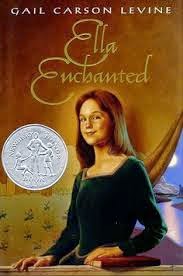As a Cinderella story, the basic plot of Ella Enchanted is recognizable enough for less confident readers to know what's coming, so they can focus on the nuances--and there are nuances. In a Harper Collins discussion guide that seems to be gone, now,* Levine mentions that she didn't want Ella to be a "goody two shoes," and creating the curse provided a way to add tremendous depth to her character. Ella is no damsel in distress. The relationship between Ella and her fairy godmother are different, as well. The real difference, though, is in the way Ella rails against the curse every day, even as she seeks a way to have it lifted or countermanded.
Both at home and at finishing school, Ella deals with situations kids can identify with: parents who don't listen or who dismiss kids' concerns, siblings who seem to get away with everything, and holding one's own in the face of peer pressure. How far can we bend the rules while still following them? What constitutes obedience?
Ella Enchanted gives kids a chance to discuss the difference between the letter and the spirit of the law, and why we must sometimes make the choice to not do what is expected of us.
*(though I know it existed, because I still have the pdf version in my files)

No comments:
Post a Comment